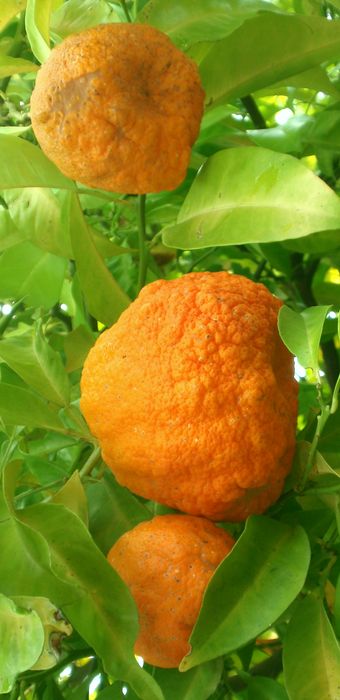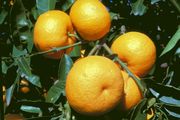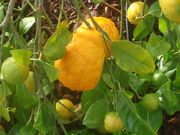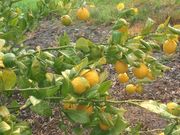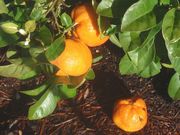|
|||||||||||
| |
Select any of 50
available languages! |
 |
|||||||||
|
|
Sour
orange Citrus × aurantium |
History Uses Taste Varieties Orange names Classification of sour oranges Sour oranges: Common sour orange
Seville orange Bittersweet orange Paraguay, Apepu Perfumery varieties Bouquet Variegated sour orange Panaché Corniculata The horned sour orange Abers Narrow Leaf Willowleaf sour orange Leather-head sour orange Gou tou Myrtle-leaved orange Chinotto Sour orange hybrids: Bergamot
Smooth Flat Seville Kikudaidai Citrus canaliculata Yama Citrus intermedia Karna Citrus karna Kithcli Citrus maderaspatana Miaray Citrus miaray Natsumikan Citrus natsudaidai Tosu Citrus neoaurantium Zadaidai Citrus rokugatsu Sanbokan Citrus sulcata Nanshodaidai Citrus taiwanica |
|
| 'Bouquet de fleurs' sour oranges © Jorma Koskinen |
Taste
Varieties
Orange names
|
||||||||||||||
| Botanical names of sour oranges | ||||||||||||||
| In accordance with the 1996 Tokyo code of the International Code of Botanical Nomenclature where it says: "For any taxon from family to genus inclusive, the correct name is the earliest legitimate one" the botanical names on this Sour Orange page have been changed to Citrus × aurantium L. of Carolus Linnaeus from 1753. The most common later classifications are given as synonyms. See: Citrus Classification | ||||||||||||||
|
|
||
| LAT | Citrus × aurantium L. |       |
| Syn | Citrus aurantium var. amara Engl. |
|
|
Sour orange, Common sour orange or Standard sour orange, also known as bitter orange and in food contexts as Seville orange, very much resembles the sweet orange. The rind is usually much thicker, rough on the surface and hard to peel. The sour orange is seldom very juicy and often has many seeds. When fully ripe the core at the centre of the segments becomes hollow. An important part of the world production is sold to England, Scotland and South Africa where it is made into marmalade. The orange marmalade preferred by the British is made out of sour oranges only and a marmalade made from sweet oranges is not acceptable. Some sour oranges are often added to regular sweet orange marmalade to improve its flavour. The dried peel of sour orange is used as a spice in baking and confectioneries. The flower of the sour orange is the source of Neroli oil (produced by steam distillation) and Neroli absolute (produced by solvent extraction). The flowers yield nectar for honey bees. Neroli petitgrain oil is made from leaves and twigs by steam distillation. Neroli bigarade oil is made from the peel of nearly ripe fruit by cold expression. These oils are widely used in perfumery and cosmetics, and as a flavouring agent in foods, alcoholic and soft drinks. They are also used in aromatherapy. For more information see citrus oils, bittersweet orange and perfumery varieties. Genuine orange flower-water is a by-product of the steam distillation of oils. The thick peel of certain types of sour orange, especially 'Jacmel' in Jamaica, is cut into segments, which are dried in the sun. They are then soaked in pure alcohol in a process called maceration. Later this mixture is distilled and the clear liquid obtained is used for flavouring citrus liqueurs such as Grand Marnier and Cointreau. The dried peel of a sour orange variety from the island of Curaçao is used in the making of citrus liqueurs Curaçao and Triple sec. The peel and seeds also have medicinal uses and are used in making soap. All parts of the sour orange can be used. It adapts easily to varying conditions and survives with little or no care. It can stand several degrees of frost for short periods. In proper conditions the tree can attain exceptional longevity. Some trees in Spain are said to be over 600 years old. Some cultivated varieties with their country of origin: Algeria: Algerian, Trabout Brazil: Azeda, Brazilian, Jaboticaba, Viradouro China: Gou Tou, Huahong, Vermilion globe, Xiaohong Cheng Corsica: Cardosi, Filippi, Luisi, Santucci Cuba: Cajel, Cuban France: De Grasse, Donnet, Menton Italy: Bizzarrio, Gallesio, Palermo, Sicilian Jamaica: Jacmel Japan: Du Japon, Konejime, Shuto, Variegated Morocco: Maroc Paraguay: Paraguay Spain: Bouquetier de Nice à fleurs doubles, Espagne, Sevillano (Seville) Tunisia: Alibert, Petit Pierre, Tunisian United States: California, Carson, Florida, Fraser, Granitos, Hawaii, Merrits, Nahala, Oklawaha, Olivelands, Rubidoux, Sespe, Standard, Texas Curaçao: Curaçao, Laraha Vietnam: Commune, De My Tho |
||
| ENG | Sour
orange, Common sour orange, Seville
orange, Bitter orange |
|
| FRA | Orange amère (fruit), Oranger à fruits amers (tree) | |
| GER | Bittere Orange, Pomeranze | |
| I TA | Arancia amara, Melangolo | |
| SPA | Naranja ácida, naranja agria (fruit), naranjo amargo (tree) | |
| Photos | (1,3,5) © Jorma Koskinen (2,4) © J.-M. Bossennec / INRA (6) © C. Jacquemond / INRA |
|
|
|
||
| LAT | Citrus × aurantium 'Sevillano' |   |
| Syn | Citrus × aurantium
'Real' Citrus × aurantium 'Agrio de España' |
|
| 'Sevillano' is the sour orange variety grown in southern Spain in and around the city of Seville. Unlike the 'Bittersweet' (see below) this variety was brought directly to Spain by Arab conquerors in the 10th century from northern Africa via Morocco. This was the original Seville orange and later became known as the standard sour orange. The variety is also known by its Spanish name Real (royal), Agrio de España (Spanish sour). The tree is attractive, large, vigorous, productive and cold tolerant. It has very few or no thorns. The fruit is seedy, bitter, and acidic, medium size, round, with a slightly depressed apex and a pebbled dark orange rind. This is the principal marmalade variety. It is exported chiefly to England and Scotland for orange marmalade production. The typical bitterness combined with its sour orange characteristics make it an ideal variety for this. The Spanish production area in 2006 was 1120 hectares (2770 acres) and the production around 17 000 metric tons. |
||
| ENG | Seville orange, Common sour orange, Common bitter orange | |
| FRA | Bigarade sans épine, Bigarade d'Espagne | |
| Photos | (1) © C. Jacquemond
/ INRA © UCR Citrus Variety Collection |
|
|
|
||
| LAT | Citrus ×
aurantium ' Bittersweet
group' |
 Bittersweet  Dummet Bittersweet of Florida  Paraguay  Apepu |
| Syn | Citrus aurantium var. bigaradia Hook f. Citrus bigaradia Risso & Poit. Citrus bigarradia Loisel. |
|
|
The Bittersweet orange came from the Near East to Europe with the returning crusaders in the 12th and 13th centuries. The tree is known to have been commercially grown in the Nice area from the year 1322 (as opposed to the 'Sevillano' above). This is the sour orange that first reached Paris and Versailles and became the favourite of kings and aristocrats or anyone who could afford to build the special greenhouses called orangerie that were needed for growing them. This was also the first orange to reach the New World with the second voyage of Columbus (1493). It quickly established itself in suitable surroundings like Florida and Paraguay, where the largest cultivated areas still are and where it soon started to grow wild. The tree is large and thorny, the fruit medium size, globose and with a smoother rind texture than the common sour orange. The rind is medium thick and seeds are numerous. The taste is sweet but bitter at the same time. The distinguishing feature is the relative lack of acidity, which makes these varieties almost palatable to some. The two main varieties Bittersweet and Paraguay (Apepu) have acquired slightly different characteristics: Bittersweet has more sugar whereas Paraguay is subacid and therefore sometimes actually tastes sweeter. In its cultivation area the bittersweet orange is used for making marmalade. In the Caribbean islands dried peel is used to aromatize citrus liqueurs. The juice is also used for marinades. The mojo of Cuba is a marinade of half sour orange juice and half oil, spiced with garlic and onions. The leaves and twigs of the bittersweet orange are used to make petitgrain (Paraguay) oil by steam distillation. The peel of the immature fruit is used to obtain bigarade oil by cold expression. These oils are not as highly esteemed as Neroli petitgrain or Neroli bigarade from the common sour orange, but they are largely used in perfumery and in aromatherapy. The most important producer of these is still Paraguay. For more information see citrus oils. Cultivated varieties: Orlando, Dummet, Bittersweet of Florida and Paraguay (Apepu). |
||
| ENG | Bittersweet orange, Paraguayan Bigarade | |
| FRA | Bigarade Paraguay, Bigarade Apepu | |
| Photos | (1) © Gene Lester © UCR Citrus Variety Collection (4) © C. Jacquemond / INRA |
|
|
|
||
| LAT | Citrus × aurantium ’Bouquetier group’ |  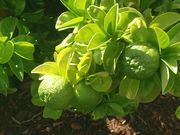   'Bouquet de fleurs'  'Bouquetier de Nice à fleurs doubles' |
| Cultivated
varieties: Citrus × aurantium ’Bouquet’ Citrus × aurantium ‘Bouquetier à Grandes Fleurs’ Citrus × aurantium ‘Bouquetier de Nice à Fleurs Doubles’ In Algeria: 'Bouquetier à fruits mous' |
||
There is some confusion about these perfumery varieties. On the French Riviera and around the town of Grasse as well as in Algeria and Tunisia several sour orange varieties are grown solely for their flowers, which yield a superior quality of Neroli oil that is used in perfumery and aromatherapy. The trees are small, some even dwarfish, and the small fruit are often discarded, although they can be used for making petitgrain and bigarade oils. The flowers of these varieties differ. The flowers of the most highly prized varieties are doubled. The bottom picture shows one of the most valued varieties called the Double-flowered Bouquetier of Nice. The oil obtained from these varieties is more expensive than gold. Bouquet (Bouquet des fleurs) has small, oval leaves and dense clustered foliage. The fruits are small, moderately pebbled and well-coloured. Bouquetier à grandes fleurs is the most important perfumery variety. It has very large, simple flowers and large round fruits with very thick rinds. The tree is small and spineless. The fruit makes excellent confections. Bouquetier de Nice à fleurs doubles has doubled flowers, which develop into double fruits that have a secondary fruit inside the primary. The leaves are very large and broad. The word bouquetier means either a small narrow vase for holding nosegays or a flower-seller, the feminine form bouquetière means a flower-girl. Bouquet is a bunch of flowers, among other things. There are several named cultivars, see above. For more information on the oils, see citrus oils. |
||
| ENG | Bitter
orange perfumery varieties |
|
| FRA | Bigarade
bouquet
(Bouquet de fleurs,
Bigarade riche dépouille) Bigarade bouquetier à grandes fleurs (à peau épaisse) Bigarade bouquetier de Nice à fleurs doubles (bouquetier à fruits plats) |
|
| Photos | (1-2) © Jorma Koskinen (3-4) © Gene Lester (5) © Home Citrus Growers |
|
| LAT | Citrus × aurantium 'Corniculata ' Horned sour orange |    |
| Syn | Citrus × aurantium 'Cornuto',
'Corniculé', 'De Grasse', 'Horned' |
|
The Horned sour orange 'Corniculata' is an old ornamental form of sour orange that was already known to Volkamer as Aranzo Cornuto in his Hesperides from 1708. This variety can sometimes grow digit-like curved extremities that look like small horns. The formation is similar to the way the Fingered citron (Buddha's hand) grows its "fingers". In their famous book Histoire Naturelle des Orangers published in 1818 Risso and Poiteau described and illustrated this variety as Bigaradier à fruit corniculé, the "sour orange with horned fruit" and in Italian it was called Melangolo a frutto cornuto. This variety was thought to have been lost until a clone of it was found near the town of Grasse in southern France. This variety is now called 'De Grasse'. The tree has a low bushy form of growing and is usually wider than it is tall. |
||
| ENG | Horned sour orange |
|
| FRA | Bigarade corniculée |
|
| Photos | © Jorma Koskinen | |
|
|
||
| LAT | Citrus × aurantium 'Abers Narrow Leaf' |   |
| Syn | ||
|
Abers Narrow Leaf is an extremely narrow-leaved form of sour orange The tree is small and drooping in habit and the fruit is typical of bitter orange except that the calyx is fleshy. The presumption is that Abers Narrow Leaf originated in Florida, where it received its name, though it may have been an introduction. In
appearance
it somewhat resembles the Granito and the Willowleaf
variety, but is not identical with either one. |
||
| ENG | Abers
Narrow Leaf sour orange |
|
| FRA | ||
| Photo | © Gene Lester |
|
| LAT | Citrus × aurantium 'Willowleaf' |   |
| Syn | Citrus × aurantium var. salicifolia |
|
In their famous treatise of 1818 Risso and Poiteau published a picture and a description of a Bigaradier à feuilles de saule, a sour orange with willow-like narrow leaves. This variety is reported to have originated in 18th century Italy. Willowleaf is an ornamental sour orange. The tree is moderately dwarfed, of highly symmetrical round-topped form, with dense compact foliage consisting of small, narrow, sharp-pointed, yellowish-green leaves. Fruit is small, round to pyriform, yellowish orange and about one third to half of normal sour orange size. Rind thick and rough. Pulp yellow, sour; few seeds. The juice is very acid and somewhat bitter. Only one clone of Willowleaf has been noted in California and its origin and history are unknown, although it is believed to have been introduced under the botanical variety name salicifolia. It is markedly different from Abers which has sometimes been called Willowleaf. Willowleaf forms grow true from seed. |
||
| ENG | Willowleaf
sour orange |
|
| FRA | ||
| Photo | ©
UCR Citrus Variety Collection |
|
| LAT | Citrus ×
aurantium 'Chinotto
Group' |
 'Chinois à grandes feuilles'    |
||||||||||||||
| Syn | Citrus bigaradia Risso & Poit. var. chinensis Citrus myrtifolia Raf. Citrus aurantium var. myrtifolia Ker-Gawl. |
|||||||||||||||
Myrtle-leaved orange gets its name from the myrtle (Myrtus communis) because its leaves resemble those of the myrtle. The leaves grow densely and the fruit hang on the tree for most of the year, which makes it an attractive ornamental plant. The myrtle-leaved orange is grown on the Mediterranean coast of France and in Italy as well as in the citrus zones of the US. The French call it chinois (Chinese). The tree was introduced from China. The Americans call it by its Italian name chinotto. There is an Italian home page for "chinottofiles", friends of the chinotto. The Chinotto homepage tells you everything you want to know about this tree, and more. Surprisingly it lists dozens of different kinds of soft drinks and beverages made of chinotto. Presumably most of these are only available in Italy, the promised land of chinotto enthusiasts. The fruit are too sour to be eaten fresh but they are candied whole and eaten as a luxury dessert. Four main varieties of chinotto are grown:
|
||||||||||||||||
| ENG | Chinotto,
Myrtle-leaved
orange, Chinotto orange, Myrtle leaf orange (US) |
|||||||||||||||
| FRA | Orange à feuilles de myrte, Bigaradier chinois | |||||||||||||||
| GER | Myrtenblättrige Bitterorange | |||||||||||||||
| I TA | Chinotto, Arancio a foglia mirtella | |||||||||||||||
| SPA | Naranja mirtifolia | |||||||||||||||
| Photos | (1) © C. Jacquemond
/ INRA (2-3) © Jorma Koskinen (4) © Catherine Foucaud / INRA |
|||||||||||||||
|
|
||
| LAT | Citrus ×
aurantium
'Bergamot Group' |
      |
| Syn |
Citrus × aurantium ssp. bergamia (Risso et Poit.) Wight & Arn. ex Engl. Citrus bergamia Risso Citrus × aurantium var. bergamia Loisel. |
|
|
The bergamot is of hybrid origin. It has been suggested that Bergamot is only known from cultivation and consists of a limited and well Only cultivars in the Common bergamot group are commercially cultivated for the essential oil and three cultivars are grown: 'Femminello' is somewhat less vigorous Juice: The juice of the fruit was formerly used to prepare calcium citrate and citric acid, while nowadays it is a Pulp: The pulp is used as animal feed and for the extraction of pectins. Essential oils: Bergamot is mainly grown for the essential oil present in the peel of its fruit (bergamot oil). Bergamot oil Cosmetics: The oil is further used in skin care products (bronzers), soaps, lotions and creams. Other uses: Bergamot oil is also a characteristic additive of Earl Grey tea and of tobacco flavourings. In the Castelli In the Mediterranean area flowering is in March-April, fruits are harvestable in December- February. The commercial cultivation of Bergamot is limited to the coasts of the Calabria region of Southern Italy where the Ionian Sea and the nearby mountain range protect the coastal areas from cold weather and northerly winds in the winter.The Cultivated varieties: 'Castagnaro', 'Femminello' and 'Fantastico ('Inserto') |
||
| ENG | Bergamot,
Bergamot orange, Lemon bergamot |
|
| FRA | Bergamote, Bergamotier (tree) | |
| GER | Bergamotte, Strauchorange | |
| I TA | Bergamotta (fruit), Bergamotto (tree) | |
| SPA | Bergamot | |
| Photos | (1-2)
© Gene Lester (3) © Franck Curk / INRA (4) Mäurer & Wirtz GmbH & Co. (5-6) © Jorma Koskinen |
|
1 RFLP analysis of the origin of Citrus bergamia, Citrus jambhiri, and Citrus limonia Federici, C.T., Roose, M.L. and Scora, R.W. 2000. Acta Hort. (ISHS) 535:55-64 http://www.actahort.org/books/535/535_6.htm http://plantbiology.ucr.edu/faculty/roose.html#2 |
||
| LAT | Citrus × aurantium 'Smooth Flat Seville ' |  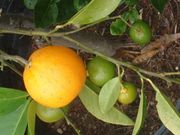 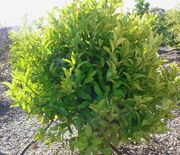 |
| Syn | Citrus × paradisi
'Smooth Seville' |
|
Smooth Flat Seville is an old Australian fruit that is thought to have originated as a seedling of unknown parentage and has generally been regarded as either a sour orange or a sweet orange and grapefruit hybrid. Its age and numerous resemblances to Poorman orange, however, suggest that it may be of similar origin and possibly a sister seedling. Fruit is similar to Poorman in size, form, and flavour, but rind surface is very smooth. Both rind and flesh colour is reddish-orange. Tree and foliage similar to Poorman but tree commonly more vigorous and larger. Younger branches also exhibit dark bark streaks characteristic of Poorman. Like Poorman, Smooth Seville has a lower heat requirement for maturity than the grapefruit and hence ripens earlier and serves as a satisfactory substitute. |
||
| ENG | Smooth
Flat Seville, Smooth Seville |
|
| FRA | ||
| Photos | (1-2) © Jorma Koskinen (3) © Gene Lester |
|
|
|
||
| LAT | Citrus ×
aurantium 'Yama' |
 |
| Syn | Citrus intermedia Tanaka Citrus × aurantium L. f. intermedia ( Hort. ex Tanaka ) M.Hiroe |
|
Observations made on the Yama or Yama-mikan cultivar grown at the UC-Riverside Citrus Variety Collection include: "A large fruit, wide 9.5 cm, height 7.9 cm, similar to Natsudaidai in size, shape & color, oblate to slightly oblique shaped, stem end flat, slightly bumpy, rind 7.8 mm, very hollow center, 25-30 seeds, fruit is acid, low solids, leaves large, acuinate tips, petiole average, large wings on petiole (like grapefruit)." "Slightly necked, grapefruit-colored fruit; rind 1 cm thick; large oil glands, marked aroma of sweet orange; light orange flesh, tender, juicy, fairly sweet and pleasant; fairly seedy. Large tree. Seems like a hybrid of sweet orange and grapefruit, by the fruit." Yama is known as Shan mi gan in Chinese |
||
| ENG | Yama, Intermediate orange, Yama-mikan sour orange, Mountain citrus | |
| FRA | Pomelo
Yama |
|
| Photo | © UCR Citrus Variety Collection | |
| LAT | Citrus ×
aurantium 'Miaray' |
 |
| Syn | Citrus miaray Wester | |
Miaray is closely related to Japanese summer orange (Citrus natsudaidai), Nansho-daidai (Citrus taiwanica) and Sanbokan (Citrus sulcata) A handsome ornamental tree suggested as a rootstock for cultivated citrus fruits. It has slender drooping willowy branches, dark-green leaves, and ornamental looking fruit. However, the taste is very sour and bitter and leaves a foul after taste in one's mouth. Foliage lanceolate, pointed, somewhat mandarin-like, with lined to narrowly winged petioles. Young growth has slightly purple tinge. Small, round, bumpy fruit of yellow to orange color. Rind medium-thick. Seedy. Flesh light yellowish orange. |
||
| ENG | Miarai
sour orange |
|
| FRA | Pomelo
miaray |
|
| Photo | © UCR Citrus Variety Collection | |
| LAT | Citrus ×
aurantium 'Sanbokan' |
 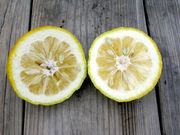   |
| Syn | Citrus sulcata Takahashi Citrus × aurantium L. subf. sulcata ( Ik.Takah. ) M.Hiroe |
|
|
Sanbokan (Sanbô) is an old Japanese fruit of unknown origin. It was first described in 1848 and is still popular and grown mainly in the Wakayama Prefecture of Japan. It was early classified as a sour orange hybrid and indeed, molecular analysis has shown it to be a close relative of Nansho-daidai (Citrus taiwanica). Due to its popularity and the shape and taste of the fruit is has many names: Sanbokan lemon, Sanbokan Sweet Lemon, Sanbokan grapefruit. This comparatively cold resistant 10 -15 feet tall tree bears large grapefruit-sized obovoid fruit. The prominent collar or neck of the mature fruit is a distinguishing feature. The yellow, coarsely pebbled rind is medium thick, about 1 cm, and easily removed. The flesh is seedy, moderately juicy, sweet and has a good flavour. The leaves are fairly small, slightly winged with a petiole slightly shorter than average. The flavour of Sanbokan is lemon-like but sweeter. It can be used as limes and lemons. The juice tastes somewhat like sweetened lemonade. Sanbokan is San bao gan in Chinese and Sanboukan in Japanese |
||
| ENG | Sanbokan
sour orange, Sanbokan Sweet Lemon, Sanbokan grapefruit |
|
| FRA | ||
| Photo | © Laaz |
|
| LAT | Citrus ×
aurantium 'Nanshodaidai' |
    |
| Syn | Citrus taiwanica Tanaka & Y. Shimada Citrus nanshô-daidai |
|
Nansho Daidai sour orange (Citrus taiwanica) was found growing semiwild in forests of Taiwan (formerly Formosa, present day Chinese Taipei) especially in the Nan Zhuang (formerly Nanshô) district. Nansho resembles the ordinary Japanese sour orange (Daidai) but has much longer lanceolate leaves (12-15 cm) that are sharply pointed and the yellow fruits are somewhat flattened, slightly necked with a small nipple at the apex. The tree is vigorous, upright-spreading, and very thorny. Flesh is juicy with an acid flavour and bitter aftertaste. Flesh colour is dull yellow. Recent molecular studies have shown it to be a close relative of Sanbokan (Citrus sulcata) and as a pomelo-mandarin hybrid studies have placed it at about 60% pomelo - 40% mandarin. Nansho Daidai is very hardy. It tolerates freezing temperatures well for a certain period without leaf drop or loss of crop the following season. It is reported to have survived temperatures down to 5° F (-15° C). Nansho Daidai is one of the hardiest evergreen citrus trees. Nansho Daidai is known as Nan zhuang cheng or Nan zhuang dai dai in Chinese and Nanshou daidai in Japanese. |
||
| ENG | Taiwan
orange, Nansho Daidai sour orange |
|
| FRA | Bigarade nanshô-daïdaï | |
| Photo | (1-2) © Gene Lester © UCR Citrus Variety Collection |
|
e-mail to Citrus Pages
|
|
Page up-dated 03 March 2011
http://users.kymp.net/citruspages/souroranges.html
